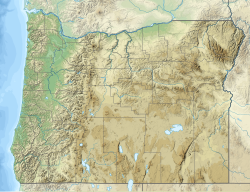The Alsea Formation is a geologic formation in Oregon. It preserves fossils dating back to the Rupelian stage of the Oligocene period.[1]
| Alsea Formation | |
|---|---|
| Stratigraphic range: Rupelian (Whitneyan) ~ | |
| Type | Formation |
| Underlies | Yaquina Formation |
| Lithology | |
| Primary | Siltstone |
| Other | Mudstone |
| Location | |
| Coordinates | 44°36′N 124°00′W / 44.6°N 124.0°W |
| Approximate paleocoordinates | 44°18′N 113°06′W / 44.3°N 113.1°W |
| Region | Lincoln County, Oregon |
| Country | |
Fossil content
editThe following fossils have been reported from the formation:[1]
Mammals
editFish
editSee also
editReferences
edit- ^ a b Alsea Formation at Fossilworks.org
- ^ Deméré & Berta, 2008
- ^ Peredo et al., 2018
- ^ Fordyce, 2002
- ^ Welton, 2016
Bibliography
edit- Peredo, C. M.; Pyenson, N. D.; Marshall, C. D.; Uhen, M. D. (2018), "Tooth loss precedes the origin of baleen in whales", Current Biology, 28 (24): 1–9, Bibcode:2018CBio...28E3992P, doi:10.1016/j.cub.2018.10.047, PMID 30503622
- Welton, B. J (2016), "First report of Orthechinorhinus (Squaliformes: Etmopteriidae) from the Pacific Basin; A new species from Early Oligocene rocks of Oregon, USA", Fossil Record, 5: 303–308
- Deméré, T. A.; Berta, A. (2008), "Skull anatomy of the Oligocene toothed mysticete Aetiocetus weltoni (Mammalia; Cetacea): implications for mysticete evolution and functional anatomy", Zoological Journal of the Linnean Society, 154 (2): 308–352, doi:10.1111/j.1096-3642.2008.00414.x
- Fordyce, R. E (2002), "Simocetus rayi (Odontoceti, Simocetidae, new family); a bizarre new archaic Oligocene dolphin from the eastern North Pacific", Smithsonian Contributions to Paleobiology, 93: 185–222, doi:10.5479/si.00810266.93.185

